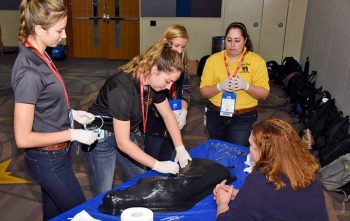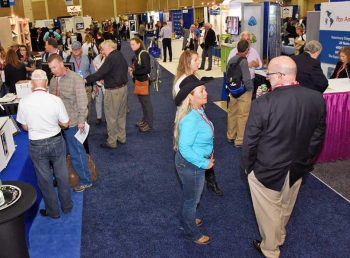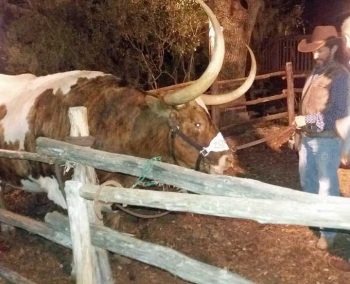2 Apr 2018
Safia Barakzai reports on the highlights at the most recent American Association of Equine Practitioners Annual Convention.

The site of the Battle of the Alamo. Image: AAEP.
San Antonio, Texas – the Spanish colonial city, famous for the Battle of the Alamo – was the location for the American Association of Equine Practitioners (AAEP) Annual Convention in November 2017.
It is the largest continuing education event dedicated to equine veterinary practice in the world, with 5,300 delegates (2,200 vets). To provide some idea of scale, the BEVA annual congress, the largest in Europe, attracts around 1,200 delegates.
The trade show at the AAEP meeting is also enormous, with more than 300 companies exhibiting. It was a shame for British visitors the poor exchange rate of the pound to the dollar was not conducive to more uninhibited purchasing. Foreign attendees who came with the expectation of “cowboys”, due to the southern location of the conference, were not disappointed, as Stetsons, cowboy boots, large belt buckles and enormous moustaches abounded among the delegates.
A successful veterinary student programme was held on the day before the main sessions started. This was designed specifically for future equine practitioners, with practical-based labs allowing students to practise day-one skills and discussion sessions on a variety of clinical topics.

The opening session on Saturday morning was introduced by the AAEP president-elect Margo Macpherson and followed by keynote speaker Nigel Marsh with his lecture “Work/life balance – a modern day unicorn for losers or something life-changingly fabulous available to all?”. Well-being, work-life balance and addressing mental illness in the veterinary profession is a snowballing subject, and its inclusion in the programme of all the largest veterinary conferences around the world is probably much overdue.
Nigel Marsh is a management consultant, communications specialist and author, whose TED Talk on work-life balance remains the most viewed given outside of the US at more than three million hits.
Mr Marsh gave an attention-grabbing and thought-provoking talk. He related to the audience his personal experience of being a very successful executive, but never seeing his young family – a familiar story for many busy vets. He suggested governments, corporations and veterinary practices were not motivated to solve the problem for us.
As individuals, we must take responsibility for the life we are going to lead. He implored the audience to approach work-life balance in a balanced way: work is not necessarily a “bad” thing, and providing stability does not need to mean a massive upheaval in your work life.
Small adjustments can radically change the balance of your life. In his case, the first step he undertook was to pick up just one of his three children from school at least once a month. In other words, start with something achievable and be careful to choose an appropriate timeframe to judge yourself on. A day or even a week is generally too short and you will likely fail. In the end, he summarised, we should be asking ourselves “what does a life well-lived look like?” rather than “the person with the most money when they die wins”. Something for us all to reflect on.
The “Kester News Hour” followed, in which specialists in equine medicine, equine surgery and theriogenology took turns to present what they believed to be some of the most clinically relevant papers published in the past year. As a member of the editorial consultant board of the Equine Veterinary Journal (EVJ), I was delighted to see more than half of the papers selected by these eminent clinicians were published in the journal, demonstrating it is leading the way for equine clinical research. The selected EVJ papers (and those referenced by Paddy Dixon in the plenary lecture) are available with open access via https://onlinelibrary.wiley.com/.
The lecture programme then split into four or five different streams, including in-depth sessions on laminitis, general sessions on business management and lifestyle/wellness, topics in clinical reproduction and a clinically based “how-to” session on equine endoscopy. Additionally, eight other “table topic” sessions facilitated discussions between experts in their field and audience members.

The second day kicked-off with an awards ceremony, where some very generous grants and prizes were given by the AAEP’s charitable trust, the AAEP Foundation. The prestigious two-and-a-half-hour-long Frank J Milne State of the Art Lecture followed, this year given by Prof Dixon from The University of Edinburgh. His lecture was entitled “The evolution of horses and the evolution of equine dentistry” and gave a remarkable insight into how the horse has evolved over 50 million years, from the small, dog-sized, forest-dwelling Eohippus into the modern-day equine.
The lecture was delivered with Prof Dixon’s classic brand of humour and encyclopaedic knowledge of dental anatomy and disease. As Jack Easley said when introducing him: “He is the man most responsible for bringing equine dentistry out of the dark ages and into the light.”
The afternoon sessions included more discussion of reproduction, a “how-to” session on ophthalmology and an “ethical dilemmas” session I attended to get a taste of something not on the usual equine conference menu. According to the AAEP board, when last year’s delegates were polled regarding the subjects they most wished to see at the next convention, veterinary ethics was the most popular.
It is a subject often not addressed openly and frankly in public forums, and I was interested to see how the discussion would pan out. The audience included a surprisingly wide range of ages and genders, whereas I had expected it to be skewed towards new and recent graduates. In fact, the moderator pointed out five or six former presidents of the AAEP were present in the audience, and it was great to hear opinions from these very experienced practitioners.
Many of the short presentations and case scenarios rang true with my experience of equine practice. Pressures of economics exist, and assistants want to “fit in” and be accepted by horse owners when they start in a new practice. Some vets, including partners and directors, appear to be awestruck by high-profile horse owners and trainers, dropping everything, bending over backwards, and bending or breaking the rules for these people.
Being asked by clients or practice owners to perform actions that may fall into the “grey zone” or even the “no-go zone” causes a huge amount of stress to veterinary assistants. This may include dispensing inappropriate medications, pre-signing health certificates (prior to export), treating animals at the trainer’s request without examination or even false certification, which can include insurance forms, clinical reports and vaccination records.

People may be encouraged to step over the line to gain clients, money, esteem or “look good” to their bosses. Practice owners’ perceptions of patient care and veterinary ethics may not align with the employee, and employees working in practices with a cultural problem of poor ethical standards often stick it out longer than they should. The problem with a lack of enforcement, and a general reticence among vets to blow the whistle and expose colleagues/bosses that behave in an unethical way, only acts to enable this undesirable behaviour. Fear of whistle-blowing may be driven by concerns about recriminations, loss of friendships and anxiety nothing might happen despite making the complaint.
In this session, younger vets were encouraged to identify mentors who align with their moral and ethical values – mentors do not have to be “old”, just a little more experienced than themselves. Many clinical situations were put forward, which presented a variety of ethical issues. One of the most interesting comments from the audience was made by one of the past AAEP presidents – apparently “blocking” a horse’s feet with Sarracenia purpurea immediately pre-competition is a common, if unethical, practice in the US. When asked what he would do if asked to block a horse in this way by a relatively new, but very large, client, he said: “Absolutely no way. If you do that, all you do is attract more and more a**hole clients, until you have a practice full of them.”
The programme at the AAEP convention is really extensive, and I can not think of many clinical subject areas not covered, thus listing them would not be particularly valuable. The convention was run over three-and-a-half days, and the session I was lecturing in (“In depth: upper respiratory case discussions”) was well attended, with much audience interaction, which is always rewarding.
The final evening was marked with an outdoor barbecue and line dancing at a local ranch, complete with longhorn cattle, cowboys and the AAEP foundation silent auction.
I give my sincere thanks to the AAEP committee for giving me the opportunity to speak and attend this great conference.